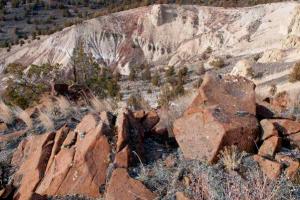
Sutton Mountain proposed National Monument lies along the John Day River in Central Oregon. Photo George Wuerthner
Thus far in his administration, President Biden has been sparing in his use of his executive authority to create national monuments. Even with his recent designation of the Avi Kwa Ame NM in Nevada and Castner Range in Texas, he has been missing in action compared to other presidents.

The Painted Hills section of the existing John Day Fossil Beds National Monument would be incorporaed into the Sutton Mt. proposal. Photo George Wuerthner
Among the many landscapes that deserve protection as a national monument is the 66,000-acre Sutton Mountain complex consisting of several Bureau of Land Management (BLM) and national park units along the John Day River northeast of Prineville, Oregon. National monument designation would offer greater protection to the area and enhance coordinated management between the BLM and NPS.

Pronghorn are among the larger mammals found at Sutton Mountain. Photo George Wuerthner
Much background work to garner support for significant protected lands by the Oregon Natural Desert Association (ONDA) began as early as 1992. In general, there is support for protection as a national monument protection from Oregon’s Senate delegation and many residents.
Senators Merkley and Wyden have introduced legislation in the past to create the national monument and plan to reintroduce legislation again.
One advantage of a legislative act of Congress is that no future president could alter the boundaries as President Trump did with the Grand Staircase-Escalante and Bears Ears NMs in Utah.

Presidential designation of Sutton Mountain could preserve Wilderness Study Area status for places like Sutton Mounain WSA. Photo George Wuerthner
However, the Presidential designation of a Sutton Mountain NM is also possible and has one advantage: it could preserve the wilderness study status of several BLM Wilderness Study Areas. However the preferred alternative at this time is the legislative option.

Some fifty million years of Earth’s geological history are visible at Sutton Mountain. Photo George Wuerthner
Sutton Mountain consists of volcanic debris and rock, including many early mammal species. The Painted Hills unit of the John Bed Fossil Beds borders the BLM lands. The area, if designated, would preserve one of the best physical records of the last 50 million years of the Earth’s geology.
The area supports abundant herds of elk, pronghorn, mule deer, and endangered steelhead in a John Day tributary, Bridge Creek. Vegetation includes abundant bunchgrass-covered slopes with juniper and sagebrush as common co-dominants.

John Day River at Priest’s Hole. Photo George Wuerthner
The Sutton Mountain Complex consists of several units (see attached map). They include several existing Wilderness Study Areas like Pat’s Cabin, Sutton Mountain, and other public areas like Priest’s Hole, Sand Mountain, Dead Dog, and Gable Creek areas with wilderness qualities. It would ban mining.

Hiker among bunchgrass hills on Sutton Mountain. Photo George Wuerthner
One of the real positive benefits of Sutton Mountain NM is that it would offer the chance to buy out existing livestock grazing permits through the Voluntary Grazing Permit Retirement. Permit retirement provide ranchers more options. Many grazing allotments have already been closed, so this area has less livestock grazing than other BLM areas. Inclusion of the Voluntary Grazing Permit Retirement in any legislation means future BLM officials can’t decide to reopen the areas.

Volcanic rocks Sutton Mountain proposed National Monument. Photo George Wuerthner
It authorizes land exchanges to consolidate public ownership in the proposed NM and also some BLM land to be conveyed to the city of Mitchell. As presented in the Merkley and Wyden legislation which Biden could adopt should he enact a national monument.

Lichens cover old growth juniper on Sutton Mountain. Photo George Wuerthner
Sutton Mountain is one of the best opportunities to protect a significant landscape-scale national monument on the John Day River, the only major undammed tributary of the Columbia River. It is an opportunity that Congress should not pass up.

Comments
You have my absolute support, George!
We should protect as much as we can.
The Biden administration has been a disappointment as far as the environment is concerned, I agree.
A related topic:
https://blog.humanesociety.org/2023/04/new-threats-grizzlies-wolves-endangered-species-act-emerge-congress.html
“Congress designed the Endangered Species Act to make listing decisions based exclusively on the best available science, yet these three extreme politicians – without an ounce of scientific qualification between them – want to jump ahead of this science-based process and de-list wolves and grizzly bears based solely on politics,” said Erik Molvar, a wildlife biologist and Executive Director of Western Watersheds Project. “These anti-science attacks on wolves and grizzlies are a cynical attempt to turn over management authority to states that have extreme predator-killing agendas and policies.”
Not an ounce! Thank you.
https://www.endangered.org/western-conservationists-blast-extinction-bills-for-wolves-grizzlies/#:~:text=The%20three%20bills%20would%20de-list%20currently%20protected%20populations,and%20debated%20at%20today%E2%80%99s%20House%20Resources%20Committee%20hearing.